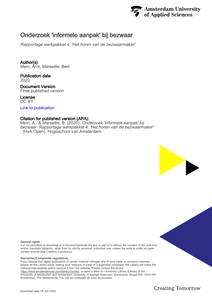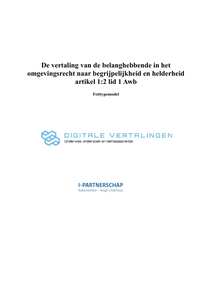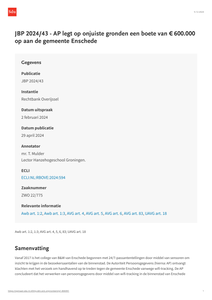Op de uitvoering van de schuldhulpverlening is de Algemene Wet Bestuursrecht (Awb) van toepassing. De Awb voorziet in (spel)regels om contacten tussen onder meer burgers en de overheid in goede banen te leiden. Hoe geven gemeenten de uitvoering momenteel vorm? En hoe kunnen ze dat beter doen?
MULTIFILE
Deze notitie bevat het verslag van een kwalitatief onderzoek naar de hoorfase van de bezwaarschriftprocedure. Dat wil zeggen de fase waarin de bezwaarmaker wordt gehoord naar aanleiding van zijn bezwaarschrift, ambtelijk dan wel door leden van een externe adviescommissie (vgl. art. 7:5 resp. 7:13 Awb).
DOCUMENT

Full text via link. Op 1 juli trad de Wet gemeentelijke schuldhulpverlening in werking. De grote winst is dat ondersteuning bij (problematische) schulden hiermee een verantwoordelijkheid van gemeenten is geworden. Om de schuldenproblematiek echt goed aan te pakken, is nog wel wat meer nodig.
LINK
This thesis is about dilemmas, discretionary space and ethics in public welfare. In my position as a lecturer of ethics in socio-legal practices I am concerned with the way in which these practices open up to an ethical development of their professionals. Thus, this thesis is a search for the most fundamental themes and issues in understanding and judging public welfare as a, perhaps, ethical socio-legal practice. In the field of public services professionals function as the intermediary between government and citizen. In their daily work public welfare professionals take care of the important societal task and goal of poverty alleviation. During the last decades, public welfare has developed into a civil right that involves many obligations on the part of the client in return. The requirement to see to it that the client fulfils these obligations has complicated the public welfare professional’s task of helping citizens in need.
DOCUMENT

Dit beroepsproduct heeft geprobeerd op hoe gemeenten op een begrijpelijke manier inzicht kunnen krijgen in de complexiteit van wet- en regelgeving. Het beroepsproduct focust zich op het begrip belanghebbende in het licht van het omgevingsrecht. Hierbij wordt helderheid enstructuur gebracht aan artikel 1:2 lid 1 Algemene wet bestuursrecht (Awb). Om dit te kunnen bereiken is op basis van het onderzoek een feittypemodel gemaakt. Op basis van dit informatiemodel wordt het begrip belanghebbende uit artikel 1:2 lid in het licht van het omgevingsrecht helder gemaakt, waarbij de betekenis ervan op begrijpelijke wijze inzichtelijk wordt gemaakt.Voor de vertaling is de aanpak Wetsanalyse toegepast. Deze aanpak doorloopt zes stappen die de vertaling tot stand brengt. Hierbij is voor stap 1 het werkgebied bepaald. Daarbij zijn relevante bronnen geanalyseerd. In het onderzoek zijn wet- en regelgeving binnen en buiten de Awb wetsartikelen, jurisprudentie, kamerstukken en bijbehorende literatuur geraadpleegd.Deze houden allen verband met het begrip belanghebbende in het omgevingsrecht. Disclaimer:De afstudeeropdracht wordt uitgevoerd door een vierdejaarsstudent in het kader van zijn/haar afstuderen bij het Instituut voor Rechtenstudies. De student levert een juridisch beroepsproduct op en doet daartoe onderzoek. De student wordt tijdens de uitvoering van zijn/haar afstudeeropdracht begeleid door een afstudeercoach. De inspanningen van de student en de afstudeercoach zijn erop gericht om een zo goed mogelijk beroepsproduct op te leveren. Dit moet opgevat worden als een product van een (vierdejaars)student en niet van een juridische professional. Mocht ondanks de geleverde inspanningen de informatie of de inhoud van het beroepsproduct onvolledig en/of onjuist zijn, dan kunnen de Hanzehogeschool Groningen, het Instituut voor Rechtenstudies, individuele medewerkers en de student daarvoor geen aansprakelijkheid aanvaarden.
DOCUMENT

AP legt op onjuiste gronden een boete van € 600.000 op aan de gemeente Enschede
DOCUMENT

Due to the rise of knowledge work since the 1980s, high job autonomy and high task variety have become common job characteristics. Knowledge workers increasingly work across multiple locations, using advanced information and communication technologies; a trend that is expected to accelerate in the post-COVID-19 world of work. As these developments fundamentally change the use of office work environments, organizations and workplace professionals have been searching for new ways to facilitate the workforce more effectively and efficiently. In the past two decades, more and more of them seem to have found the ultimate solution in activity-based working (ABW). According to this concept, workers share a variety of non-assigned work settings, enabling them to use different work settings in accordance with their varying tasks. Yet, outcomes of AWB environments generally fall short of expectations. Remarkably, while sharing the same ABW environment, some workers seem to experience fit while others do not.Optimization of perceived fit with ABW environments is important fororganizations, since it is linked to various work outcomes. Currently, this isparticularly relevant in the context of expected post-COVID-19 changes in workpractices. To find clues for optimization of ABW practice, the current PhD research project was designed to examine how workers’ jobs, tasks, behaviors, psychological needs, and demographic characteristics may be related to their perceived fit. Two survey-based studies revealed relevant workers’ attributes, which were further examined in experience-sampling field studies and a virtual reality experiment. From the findings, a clear profile arises of workers who best fit with ABW environments, i.e.: high task variety, job autonomy, external and internal mobility, social interaction, and need for relatedness; low need for privacy; few highcomplexity tasks, many non-individual tasks; appropriately using open and closed work settings; frequently switching between work settings; relatively young age.
DOCUMENT

Dit onderzoek gaat in op de vraag in hoeverre de APV mogelijkheden biedt voor het opnemen van regels die het mogelijk maken om op te treden tegen online aangejaagde ordeverstoringen. De gedachte is dat er mogelijk aanknopingspunten zijn binnen de huidige regels. Het doel van onderhavig project is het vergroten van handelingsperspectief van gemeenten bij het voorkomen van online aangejaagde ordeverstoringen. Daartoe zijn de mogelijkheden die de APV biedt, onderzocht en zo concreet mogelijk uitgewerkt aan de hand van de volgende onderzoeksvraag: In hoeverre kan de gemeente op grond van de APV (preventief) online optreden tegen online aangejaagde ordeverstoringen?
DOCUMENT

Op basis van een casestudy gaat dit artikel in op de mate van juridische kennis van lokale sociale professionals in een wijkteam in Amersfoort over de Wet maatschappelijke ondersteuning 2015 (Wmo 2015). Daarnaast worden knelpunten besproken die zij ervaren in de uitvoering van de juridische procedure. Onder mandaat van de gemeente bereiden zij een besluit voor over een maatwerkvoorziening terwijl zij hier niet per se voor zijn opgeleid. Onbekend is of zij zich bewust zijn van de juridische aspecten. Vanaf oktober 2016 tot februari 2017 zijn drie keukentafelgesprekken geobserveerd tussen sociale professionals van dit wijkteam met mensen met een beperking. Daarnaast is één casusoverleg geobserveerd en zijn zes professionals geïnterviewd. Vier keukentafelgesprekken zijn geobserveerd met mensen met een cognitieve beperking en hun belangenbehartigers in andere Utrechtse gemeenten.1 De resultaten worden besproken in dit artikel nadat we het besluitvormingsproces op papier beschrijven. In de laatste paragraaf worden onbedoelde consequenties van de rol van het wijkteam in kaart gebracht. Ook worden er aanbevelingen gedaan om de kwaliteit van besluitvorming te verbeteren zodat de rechtspositie van mensen met een beperking sterker gewaarborgd kan worden.
MULTIFILE
